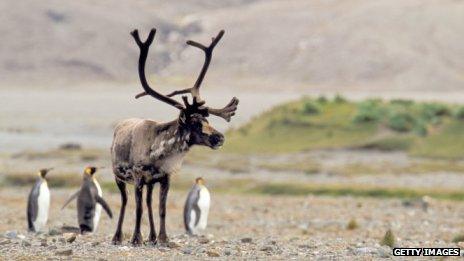South Georgia prepares to cull its invasive reindeer
- Published

Reindeer have caused great damage to the fragile South Georgian eco-system, trampling native plants and destroying birds' nests and penguin habitats
The world's mostly southerly herd of reindeer is to be culled to try to save the environment of the island of South Georgia.
The 3,000 reindeer are trampling native plants, causing erosion and endangering king penguins and other local birds by destroying their nests and habitat.
A team of Sami herdsmen from Norway have arrived and are preparing to round up and kill the reindeer.
The operation is expected to take two southern hemisphere summers.
The reindeer is more commonly seen in the Arctic, but Norwegians in need of fresh meat while on whaling missions in Antarctica brought a small herd of 10 reindeer to South Georgia in 1911.
And it is Norwegians who have been tasked with getting rid of the invasive species. The Sami people live with reindeer and their expertise is being drawn on in the cull.
Reidar Andersen, director of the Norwegian Nature Inspectorate which oversees the team, told the Reuters news agency: "The reindeer have become very destructive."
The Sami are preparing corrals into which they will herd the reindeer, then slaughter them with a captive bolt gun shot to the head. Isolated beasts may be shot with rifles.
The reindeer meat will be taken to the Falkland Islands for sale, as South Georgia has no permanent population and is only visited by scientists and government officers.

The South Georgia pipit - the Antarctic's only songbird - is threatened by the rat population
Vermin
The cull is the second eradication programme being mounted on South Georgia at the moment. A bigger task is to rid the territory of its rats, which arrived on board sealing and whaling vessels throughout the 18th and 19th centuries.
From February scientists will target 220 square miles (580 sq km) with poison pellets to reduce the rat population, which is estimated at 200 million. A trial programme in 2011 appears to have been successful and scientists hope that seabird numbers will rise if they can get rid of the vermin.
The rats have no natural predators and eat the seabirds' eggs and chicks. Two of the indigenous bird species - the South Georgia pipit and pintail - are particularly at risk.
Scientists say they have already seen a rise in sea bird numbers and hope that the islands will again support a population of 100 million birds.
- Published29 November 2012